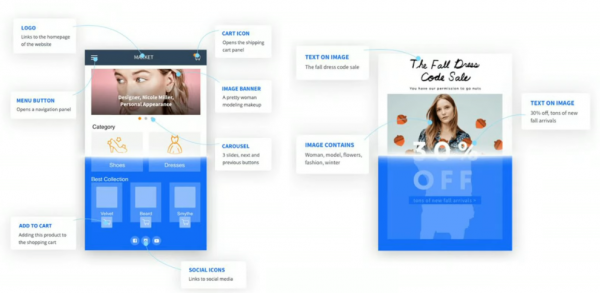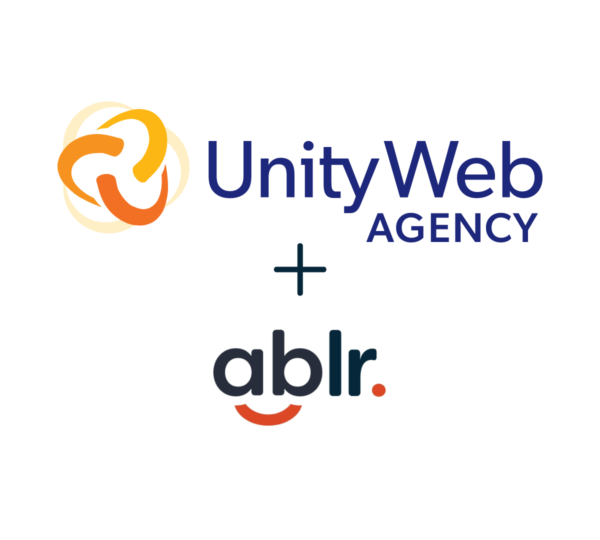Read time: 7 minutes
If you’re a business owner with a website, it’s likely you’ve heard about web accessibility overlays.
Maybe you heard about it through a friend or peer.
Perhaps you’ve accidentally clicked on an AccessiBe advertisement and been subjected to their numerous video ads.
(Disclaimer: we highly recommend you do not click on their ads)
Or maybe you’re one of the 250 businesses that have, unfortunately, been sued in 2020 because of these overlays.
Within the web accessibility industry, overlays have been one of today’s biggest talking points, and for good reason.
But if you’re not familiar with what a web accessibility overlay is, here’s what you should know and whether or not it’s right for you.
(Hint: it’s not recommended)
What Is An Overlay?

A web accessibility overlay is a short piece of code that businesses add to the backend of a website. Once it’s installed, the theory is that the code will detect and “fix” any web accessibility issue your site may have over a certain period of time.
For some companies, the claim is that this code can make a website — including those that weren’t built with accessibility in mind — fully accessible in as little as 48 hours.
Additionally, this code will also pull up a pop-up menu, where visitors will be able to toggle certain features around a site like reduced motion, increase text size, eliminate flash, reduce color, and more.
The menu is sleek, easy-to-navigate, and even offers definitions for some of the hard-to-understand web accessibility topics.
Oh, and if you’re a little skeptical, don’t worry.
Many of these companies have incredible social proof, as they’ll have notable brands such as Oreo, Pillsbury, Energizer, and even the Los Angeles Lakers as clients.
Just looking at that information, it sounds pretty great, right?
It’s basically a silver bullet!
(At least that’s how it’s advertised)
But the truth is that web accessibility overlays add another level of complexity to your site.
Something you don’t want to deal with.
Why Overlays Aren’t The Solution
So, why don’t overlays work?
We’ll break it down into three sections:
Convenience, Not Consideration

Simply put — overlays aren’t built for people with disabilities.
Let us explain.
Yes, overlays are technically used to make a website more accessible.
Yes, overlays technically have a variety of tools and functionality to accommodate certain disabilities.
But the truth is that this software was never built with people with disabilities in mind.
This software was built to primarily protect businesses from lawsuits.
It was built because, frankly put, people did not want to invest the time, money, and effort to make their website accessible themselves or enlist the help of an agency or professional who specializes in accessible web development and design.
What business owners wanted was convenience and protection, and this product “gave” them exactly that.
While we completely understand that small businesses want a quick and affordable way to ensure their website is accessible, it’s worthwhile to invest in approaching accessible design in a way that will actually make your website accessible rather than simply “compliant.”
But the problem around this software doesn’t start and stop there, and this “affordable” solution may be a bigger investment than you might think.
Monetized Longevity

When it comes to building an accessible website, there are a lot of implementations and techniques we do to ensure that not only is a website accessible in the present, but that it’s accessible in the long term.
Regardless of whether a client chooses to work with us after receiving their website.
The problem — which is brilliantly laid out in “Honor The ADA: Avoid Web Accessibility Quick-Fix Overlays” — is that with these overlays, you need to pay an on-going license.
So if your business ever chooses to move away from a specific overlay product…
Boom.
Your site is no longer accessible.
(Seriously, check out that article if you have a chance. It’s brilliantly written and offers great resources for further learning.)
For us, web accessibility should never be a “your site is only accessible if you consistently pay us” service.
Although we do get paid for our work, we want to make sure that a business’ site is fully accessible well after they’ve stopped working with us.
And that leads us to our last point:
Overlays only fix approximately 30% of web accessibility issues.
Technical Shortcomings

One of the things that people love (and get intimidated by) with the Web Content Accessibility Guidelines (WCAG) is how it’s written.
It is, by design, nuanced and interpretive.
Yes, you do have certain guidelines that you need to follow, but how you get there is up to the developer.
Although this is great for people, it isn’t as good for machines.
As many within the industry know, around 30% of WCAG issues can be detected and fixed with an overlay. That’s because the more detail-oriented parts of web accessibility are hard for overlays to identify and fix, and overlays only really fix the “simple” issues of an inaccessible website.
For a website to truly undergo a full accessibility overhaul, it would need to go through manual testing and remediation.
That means having an actual professional looking through and testing the site to catch the other 70% of the accessibility issues.
Doing only 30% of the job is unacceptable for almost all jobs, so why is it suddenly ok for overlays?
But that’s not even the most egregious error.
One of the worst things about overlays is that they force people with disabilities to abandon their current tool kit and utilize what’s on the overlay.
So to ask people with disabilities to abandon their preferred resources — tools and settings that likely took time to master — in favor of something that’s completely foreign is completely unfair and, frankly, not right.
For a website to be accessible, it needs to keep these various tools in mind and accommodate them. It’s why resources like the WCAG exist, so people have a universal understanding of how to properly implement web accessibility.
Parting Thoughts
The truth is that we are years, maybe even decades, away from automated software being able to make a site fully accessible.
It might not even happen in our lifetime.
We know that may sound dramatic, but we really want to drive this point home:
To make a website fully accessible, you need real experts working on your site.
Whether it’s an audit and remediation or a full web redesign, people are the solution for creating an accessible website, not software.
Yes, technology has allowed us to rely more on software to make certain parts of web accessibility implementation easier, but as we mentioned:
We are years away from that.
If you’re looking for a way to make your website accessible, inclusive, and enjoyable for all, opt for a real, long-lasting solution.
Unfortunately, there are no easy shortcuts to make your website truly accessible.
We’d Love to Help

Are you looking to identify accessibility issues on your website the right way?
Or maybe you’re looking into a full website redesign and want the accessibility baked right in?
Regardless of what stage in your journey you are on, know that Unity Web Agency is ready to help you.
Through our partnership with Ablr, we’re able to offer full site audits and remediation using manual and automated testing (so we’ll catch 100% of the issues, instead of 30%).
You’ll know exactly what’s missing from your current site and ensure it’s fully usable by anyone.
We also offer Custom Web Development services for those that are ready to take that next step. You’ll work hand-in-hand with our team to create a site that’s not only accessible, but one that’s able to capture your mission, vision, goals, and audience.
Today's generation wants to feel included in their website experience, regardless of their ability.
Make sure you give them exactly that with your website.
